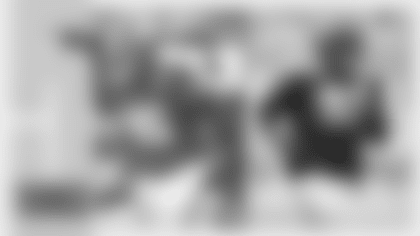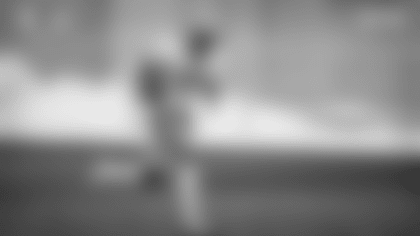If there is one thing today's Green Bay Packers fans have become accustomed to seeing, it's No. 4, Brett Favre, lining up under center.
But in 2002, the targets of Favre's laser-like passes are significantly different. Gone are veterans Corey Bradford (Houston), Antonio Freeman (Philadelphia), Charles Lee (free agent) and Bill Schroeder (Detroit), who combined for 151 starts during their tenure in Green Bay. In their place are Terry Glenn, rookie Javon Walker and Karsten Bailey, who join holdovers Donald Driver and Robert Ferguson.
Walker was drafted by the Packers in the first round of the 2002 NFL Draft after a standout collegiate career at Florida State. Prior to starring for the Seminoles, for whom he started all 11 contests last year while leading the team with 45 receptions for 944 yards and seven touchdowns, Walker spent three years as a minor league baseball player.
The Packers, who selected a wide receiver in the first round of the draft for the first time since choosing Sterling Sharpe in 1988, are excited about Walker's potential. Through three games, he has played up to his advance billing, averaging 17.2 yards per reception - a solid start for a rookie wideout expected to be a big contributor this season.
"He's an unusual rookie," Packers' head coach Mike Sherman says. "He's well beyond his years. That's why we moved up in the draft to select him. As I said a long time ago, I thought Javon was a top 10 to 15 pick. He will continue to get better and better throughout the season."
Walker helped set up the game-winning field goal in a Week 1 37-34 overtime win over the Falcons with an 18-yard reception on the decisive drive. He also scored his first NFL touchdown that day, a 13-yard catch from Favre that gave Green Bay a 27-24 third-quarter lead.
Favre, a 12th year veteran who has thrown touchdown passes to 34 different receivers in his tenure in Green Bay, likes what he has seen of his rookie target.
"Javon is young, eager and talented," says Favre. "He works hard and I appreciate his eagerness to be great. This kid can be as good as he wants to be, and I'm excited about him."
Another addition to the Packers' attack is Glenn, acquired in a trade with New England on March 11. Glenn adds a veteran presence to the receiving corps, and in his seventh season, has two 1,000-yard campaigns to his credit. The Packers brought him to Green Bay hoping he would develop into a consistent target for Favre, and through three weeks, that has been the case. Glenn has 15 receptions for 196 yards and one touchdown.
Driver, a seventh-round draft choice in 1999, has gotten off to his best start. Through three games, the former football and track star at Alcorn State is nearing career highs with 16 receptions for 223 yards and two touchdowns. Ferguson, a second-round pick in 2001, is a big, physical receiver who Favre likens to Sharpe. "He has Sterling's size, but Robert is faster," says Favre.
The Packers' overhaul at the wide receiver position is not without precedent. The team counts eight major receiver transitions in its storied history. In 1959, for instance, head coach Vince Lombardi plugged third-round draft pick Boyd Dowler into the lineup for the traded Billy Howton, and Dowler would eventually be elected to the Packers Hall of Fame. Then in 1965, Lombardi obtained Carroll Dale from the New York Giants, and Dowler and Dale would form a premier receiving tandem, helping the Packers to three consecutive championships from 1965-67, including wins in the first two Super Bowls. In 1995, Freeman was selected in the third-round and helped the Packers to consecutive Super Bowl berths.
"We lost veteran wide receivers and a lot of people are doubting what we can do," says Walker of the team's newest receiving transition. "We have to stick together and show people we will be one of the best groups in the league."














